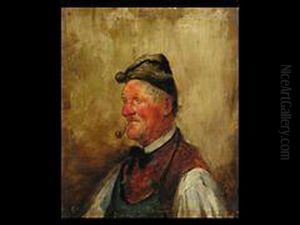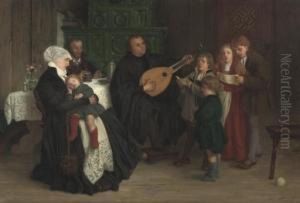Gustav-Adolf Spangenberg Paintings
Gustav-Adolf Spangenberg was a notable German painter born on February 11, 1828, in Berlin. His artistic journey was deeply influenced by the cultural milieu of 19th-century Germany, a period marked by significant political and social change that inevitably seeped into the realms of art and literature. Spangenberg’s work is often remembered for its detailed depiction of historical and genre scenes, embodying the spirit and aesthetics of the Biedermeier and Romantic movements, which were prevalent during his early years.
After initial education, Spangenberg pursued his passion for art at the Prussian Academy of Arts in Berlin. His dedication and skill quickly became apparent, earning him recognition and the opportunity to study under prominent artists of the time. In 1850, he embarked on a formative journey to Italy, a trip that was customary for aspiring artists of the era, aiming to study the masterworks of the Renaissance and the rich landscapes of the Italian countryside. This experience profoundly influenced his artistic direction, imbuing his work with a sense of warmth and a fascination with light that would become characteristic of his later pieces.
Upon his return to Germany, Spangenberg established himself as a prominent figure in the art scene of the time. He was particularly known for his historical paintings, which not only depicted events with accuracy but also conveyed the emotional and human aspects of these moments. One of his most celebrated works, the depiction of Martin Luther's translation of the Bible while in captivity at the Wartburg, exemplifies his talent for combining historical fidelity with a deep narrative quality.
Throughout his career, Spangenberg was an active participant in the German art community, contributing to exhibitions and engaging with contemporary artistic debates. His works were exhibited in various prestigious venues, including the Berlin Academy, where he once studied. Despite facing the challenges of the changing art market and the shifting tastes of the public, he managed to sustain a successful career, leaving behind a legacy that would influence future generations of German artists.
Gustav-Adolf Spangenberg passed away on October 25, 1891, in Braunschweig, Germany. His death marked the end of a career that had spanned several decades and had made significant contributions to the German art world. Today, his paintings are held in high regard, not only for their aesthetic value but also for their role in documenting the cultural and historical landscape of 19th-century Germany.

